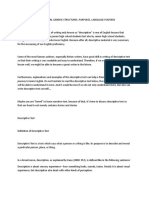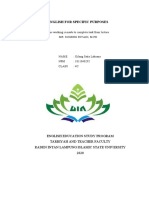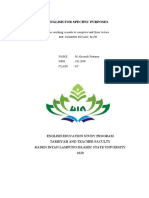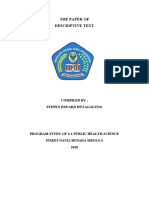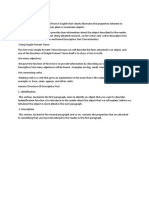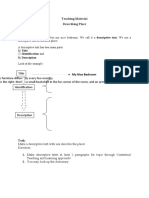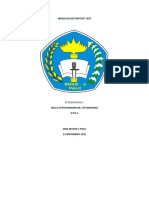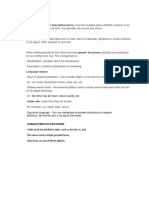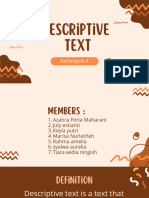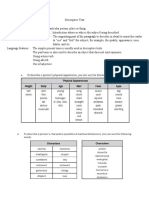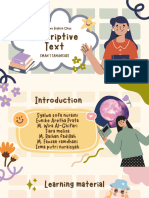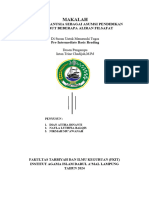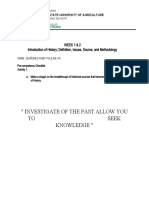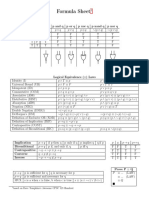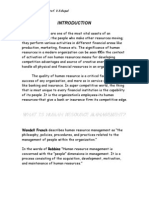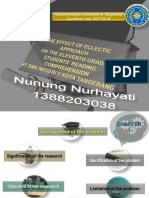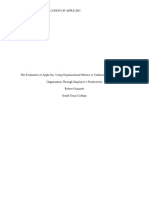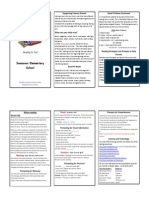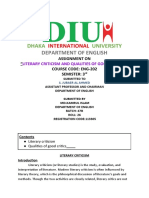Halloeverybody…
DESCRIPTIVE TEXT, or in terms of writing only known as “description” is one of English lessons
that should be mastered not only by junior high school students but also senior high school students,
college students and anyone who loves English. Because after all, descriptive material is very
necessary for the increasing of our English proficiency.
Some of the most famous authors, especially fiction writers, have good skill in writing descriptive
text, so that their writing is very readable and easy to understand. Therefore, if we were able to
master this lesson well, we might be able to become a great writer in the future.
Furthermore, I hope this explanation and example of the descriptive text can help my friend who is
still in a long journey to learn English. Do not hesitate to read the explanation of descriptive text
below, the more often we read about this text we will be able to understand it more. Furthermore it
would be nice if we do not only understand mere, but we can also write descriptive text ourselves..
Maybe you are “bored” to learn narrative text, because of that, it’s time to discuss descriptive text so
that our head is not merely contains stories and stories. Okey..
Definition of Descriptive Text
Descriptive Text is a text which says what a person or a thing is like. Its purpose is to describe and
reveal a particular person, place, or thing.
In a broad sense, description, as explained by Kane (2000: 352), is defined like in the following
sentence:
Description is about sensory experience—how something looks, sounds, tastes. Mostly it is about
visual experience, but description also deals with other kinds of perception.
Thus, if we conclude it from Kane’s explanation above, the descriptive text is meaningful text that
describes the experience related to the senses, such as what shape, sound, taste is. Most
descriptive text is about visual experience, but in fact the experience other than the sense of sight,
we can also use it to make descriptive text.
But in particular, the descriptive text is, “…… is a text which says what a person or a thing is like. Its
purpose is to describe and reveal a particular person, place, or thing.”
So, it can be said that the descriptive text is a text that explains about whether a person or an object
is like, whether its form, its properties, its amount and others. The purpose of the descriptive text is
clear, that is to describe, represent or reveal a person or an object, either abstract or concrete.
Generic Structure of Descriptive Text
When writing descriptive text, there are some generic structures (actually not mandatory) for our
writing to be true. The arrangement is:
# Identification: (contains about the introduction of a person, place, animal or object will be
described.)
�# Description: contains a description of something such as animal, things, place or person by
describing its features, forms, colors, or anything related to what the writer describes.
Purpose of Descriptive Text
– To describe person, thing or place in specific
– To describe a particular person, thing or place.
Language Feature of Descriptive Text
– Specific participant : has a certain object, is not common and unique (only one). for example:
Bandengan beach, my house, Borobudur temple, uncle Jim
– The use of the adjective (an adjective) to clarify the noun, for example: a beautiful beach, a
handsome man, the famous place in Jepara, etc.
– The use of simple present tense: The sentence pattern used is simple present because it tells the
fact of the object described.
– Action verb: verbs that show an activity (for example, run, sleep, walk, cut etc.)
Example of Descriptive Text – My Favorite Teacher
My favorite teacher is my history teacher, and he is by far the best teacher that I have ever had. He
has the ability to make a subject that many students find incredibly boring come to life through his
enthusiasm and passion for history, and his love of being a teacher. Attending his lessons is
something we look forward to, not dread, like we do with most other lessons.
It’s ever so funny to watch him get excited about something, which happens in every lesson. It’s
easy to know that he’s getting excited because he begins bouncing up and down slightly in a way
that no other sixty-something year old would ever managed without looking completely ridiculous. He
has this dark (with more and more grey streaks these days), springy hair that lines the edge of his
growing bald patch, and the hair bounces up and down with him like thousands of tiny little springs.
Then, he takes on his whole new persona, often going into role and becoming the character or figure
he is talking about, doing the voices, the actions, and parading up and down the room gesticulating
wildly, but all the while there’s a gentle ‘bounce, bounce, bounce’, as though the springs are not just
on his head but on the soles of his shoes too.
A teacher that doesn’t take himself too seriously always will be a big hit with teenagers, although
he’s not afraid to impose his authority if he has to. I’ve only ever heard him properly shout once
(although thankfully it wasn’t it me), but it isn’t an experience that I would like to repeat. When he lost
it, the room suddenly became more silent than I’d ever known it to be before. We all sat slightly
paralyzed, not even anting to breathe too loudly, because hearing such a jovial and jolly little man
lose his temper was a huge shock. It certainly had the right kind of impact though, because he’s
never needed to shout since.
It is actually this teacher that I have to thank for my love of history. In his lessons, history does not
mean copying out of textbooks and writing pages and pages of notes. History is alive; history is
something tangible, that you can see, hear and feel, and we can live it through dressing up and
acting out scenes or taking trips to important places of historical interest. And although he’s getting
on in years and may not be teaching for much longer, he will have an important place in history for
many of his students, because there has never been a teacher able to bring a subject to life in quite
the same way he does.






